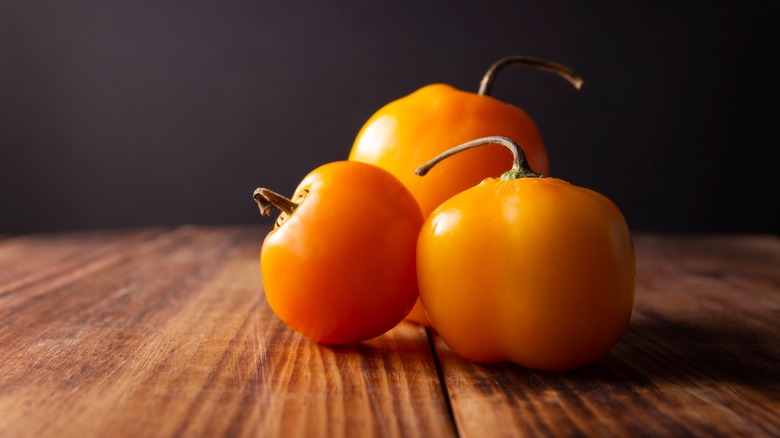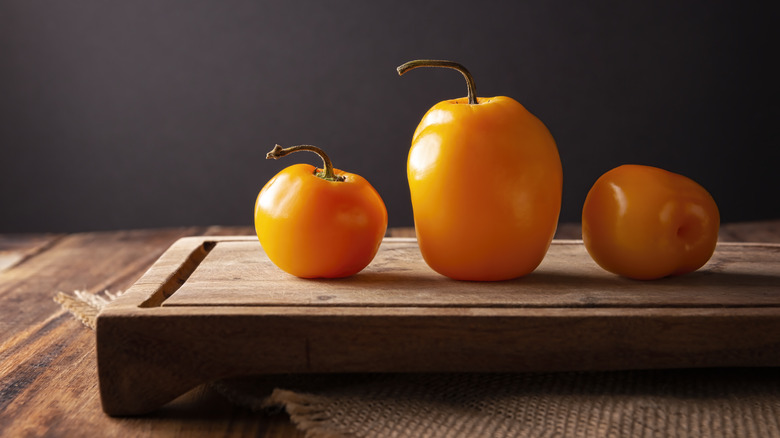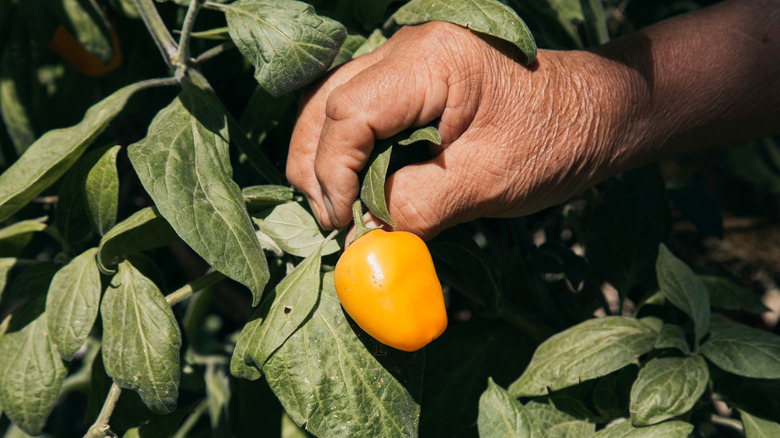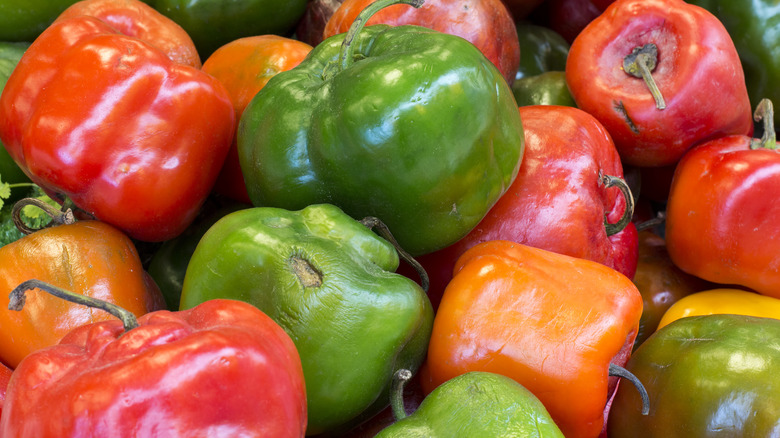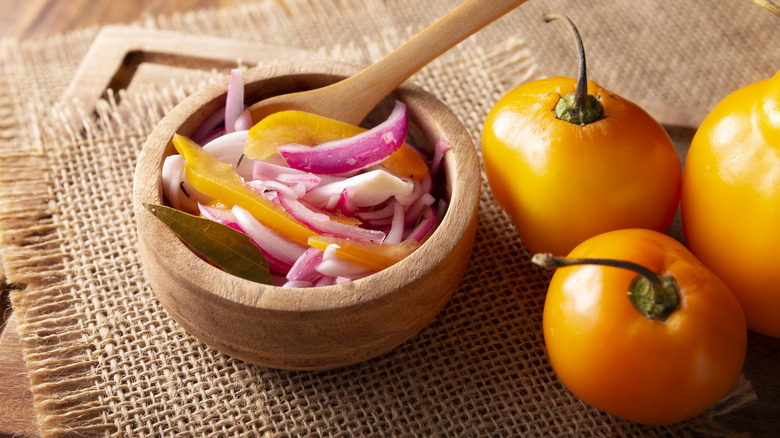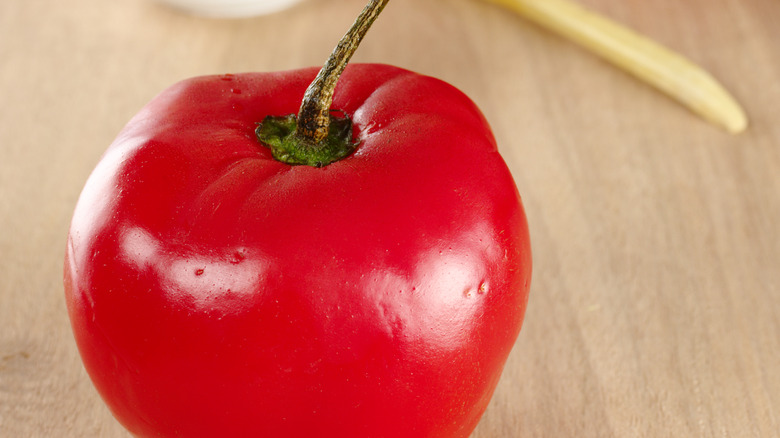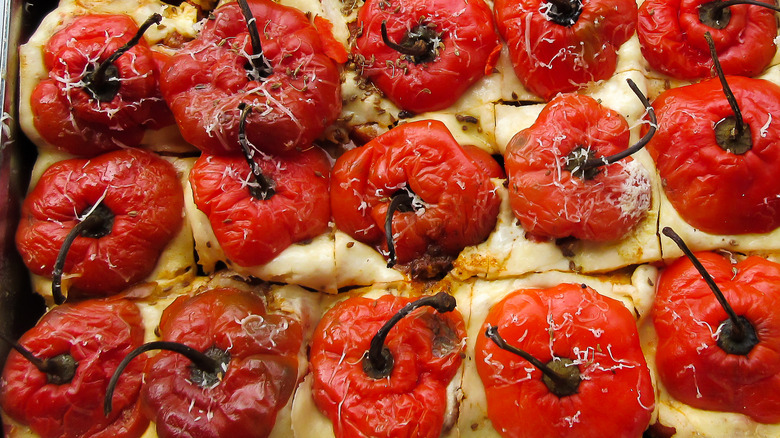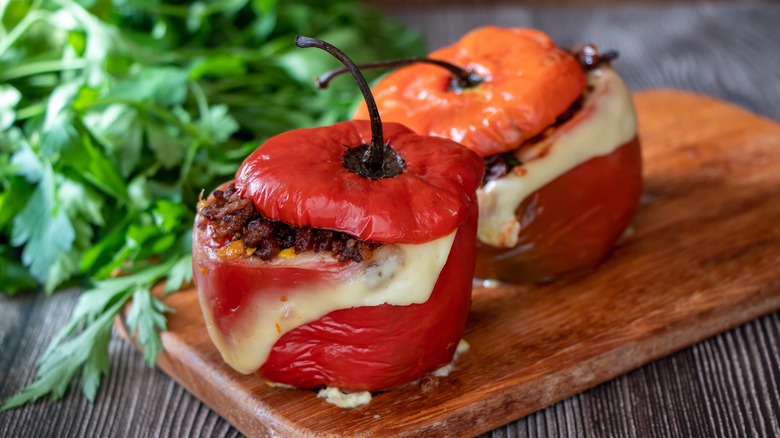South America's Rocoto Pepper Seriously Brings The Heat
When it comes to packing serious heat, rocoto peppers (Capsicum pubescens) are right up there next to habanero and Scotch bonnet varieties. While these brightly colored peppers may look cute, they deceivingly deliver up to 100,000 units on the Scoville scale of heat measurement, bringing plenty of spice to dishes. Yet the flavor of these peppers isn't all that's unique about them.
The way in which rocoto peppers grow makes them difficult to find if you're not located south of the equator. Should you manage to get your hands on these special peppers, you might find that they lend just the right amount of flavor to stews and salsas, and their thick skins offer a satisfying texture to meals. Chefs around the world have gotten creative when it comes to sneaking rocoto peppers into recipes, particularly cuisines coming out of Peru and Bolivia. We're here to give you the low down on this spicy ingredient.
What is a rocoto pepper?
Though red, orange, and yellow rocoto peppers may look similar to bell peppers at first glance, cutting into a crisp rocoto pepper will reveal small black seeds, and the dark pieces offer a sharp contrast to the bright, fleshy skin that is juicy to slice. The rocoto pepper falls into the family of nightshades and is thought to be one of the oldest peppers grown, dating back at least 5,000 years.
Found in a variety of colors and sizes, rocoto peppers can grow on vines that range from 2 to 15 feet in length, and the size of the peppers themselves can measure anywhere from 2 to 3 inches. Although rocoto peppers can be confused with manzano peppers, rocoto peppers are hotter to taste and are primarily found growing in cooler mountain climates. In fact, the areas in which rocoto peppers thrive make for one of the more unique characteristics of this compact bite of heat.
How are rocoto peppers grown?
Rocoto peppers like shady areas. Originally from areas along the Andes, South America's westernmost mountain range, rocoto peppers thrive in cooler conditions and mild temperatures that range from 45 to 60 degrees Fahrenheit. While other pepper varieties seem to grow in warmer environments, rocoto chile peppers are much more difficult to cultivate outside of mountain climates. Yet in South America and higher elevations throughout Central America and Mexico, the rocoto peppers are easily grown, harvested, and sold in markets to be used in salsas, sauces, and dishes.
Since it can be difficult to track down rocoto peppers outside of these areas, home growers around the world have taken it upon themselves to plant the unique variety of peppers at home using controlled garden environments like AeroGardens and greenhouses. If you can get your hands on some of the black rocoto seeds, you can grow these peppers for yourself in a few months' time.
What do rocoto peppers taste like?
Appearances can be deceiving when it comes to assessing the taste of a rocoto pepper. Though it can certainly bring the heat, the texture of this fleshy pepper is akin to a firm, juicy tomato, and slicing into one is a similar experience to the fresh, earthy satisfaction of cutting up a bell pepper. For as hot as these peppers can run, however, you'd think the skin would be closer to that of a jalapeño than a fruit.
Since rocoto peppers are heavy on the juice when it comes to categorizing different kinds of peppers, rocoto chiles are better used in cooking recipes as opposed to being dried and stored for use later on. In Peru, the black seeds taken from the inside of rocoto peppers are ground up into powder, and the powder is used to season dishes in need of an extra spicy finish.
How to cook with rocoto peppers
From late summer months well into the fall, fresh rocoto chile peppers are sliced into salads, placed on top of burgers, mixed into sauces, and diced into salsas in certain parts of the world. Rocoto peppers can be enjoyed raw, grilled, roasted, baked, and sautéed into recipes ranging from soups, chilis, and marinades.
In Peru, rocoto rellenos bring the heat by serving up these peppers stuffed with flavorful meat, plenty of seasoning, and melted cheese. Because the skin of rocoto peppers offers a dense container for fillings, these chile peppers can be easily packed with onions, eggs, peanuts, and beef. Rocoto peppers are also an essential ingredient needed to make a beloved Peruvian sauce that is commonly ladled on top of slow-cooked meats and roasted potatoes. When pickled, rocoto chile peppers can also offer a flavorful addition to dishes, and if stored properly in the refrigerator, fresh peppers can last up to seven days.
Where to buy rocoto peppers
For Peruvians, picking up rocoto peppers to use in tonight's dinner is a breeze. These colorful peppers can easily be found in local markets, piled high in bright stacks waiting to be collected by chefs. For the rest of us, however, finding rocoto peppers can be a bit of a challenge. Since these peppers are difficult to find, many pepper enthusiasts have set out to grow pods for themselves in their home gardens.
In Guatemala and in some regions throughout Mexico, these peppers are known as "caballo," the Spanish word for "horse," so asking for rocoto may bring about confused stares from certain shopkeepers. Similarly, in South America, the rocoto pepper can be called "locoto." While it is possible to buy rocoto peppers online, rocoto products are often packaged as paste, sauce, or jam, and when the peppers themselves are sold, they are usually preserved in brine.
Nutritional information about rocoto peppers
In addition to delivering substantial heat, rocoto peppers bring a host of nutritional benefits to those brave enough to eat them. Serving up health-supporting vitamins in every bite, rocoto peppers can boost immunity levels while offering powerful antioxidants. Additionally, the rocoto is thought to be helpful in treating ulcers and ailments of the digestive system, as capsaicin can stimulate gastric juices and encourage normal digestive fuction, and the pepper can dilate blood vessels, offering relief to patients dealing with hypertension. Among other health benefits, capsaicin is known to alleviate pain, and the compound associated with chili peppers is commonly used in topical patches and medicinal creams (per WebMD).
Should rocoto peppers be too spicy to enjoyably consume, take a page out of a Peruvian chef's cookbook and boil water with salt and vinegar, then add the rocoto peppers to bring down the heat of these potent chiles.
Varieties of rocoto peppers
Similar to the many color variations of bell peppers, rocoto peppers can also be found in assorted hues of orange, yellow, red, and green. These colors indicate how mature the pepper was left to ripen on the stem, and the size of the peppers can resemble small apples hanging on a vine.
Other rocoto varieties, like the brown rocoto, are known for their unique appearance. This rocoto presents a rich chocolate color that can add a noticeable touch to plated dishes and prepared recipes. White rocoto peppers are paler yellow in color than white but are also known for their appearance. Rocoto de seda is another yellow rocoto but grows smaller in size, reaching only about 1 to 2 inches in length and width. Rocoto largo San Isidro, named after a priest thought to grow this pepper at his church in the Canary Islands, is known for its white flowers. Finally, the aji rocoto from Ecuador offers a noticeable grassy taste that accompanies its intense heat, perfect to mince into salsas or stir into flavorful sauces for tonight's meal.
